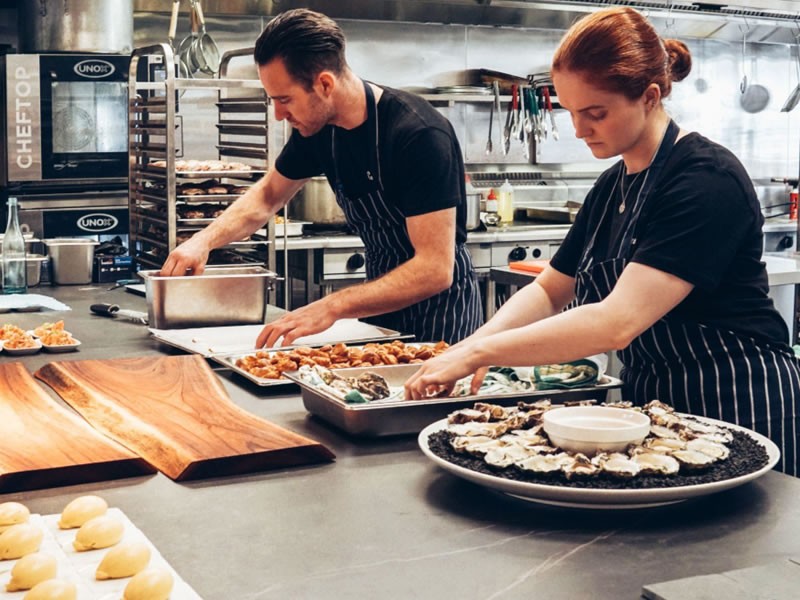Insight Blog
Agility’s perspectives on transforming the employee's experience throughout remote transformation using connected enterprise tools.
5 minutes reading time
(985 words)
Featured
8 Hiring Tips For Your Next Restaurant Recruitment Process
A Human Resources Management System (HRMS) can help find and keep great employees
According to Food Business News (FBN), "about 50% of respondents in a survey of US restaurant operators in the full-service, quick-service and fast-casual segments said they expect recruiting and retaining employees to be their top challenge in 2022…"
Between lingering covid shutdown effects, remote work opportunities, the great resignation and a job market favoring seekers, how can the hospitality industry compete in restaurant hiring?
What role can hiring software play in streamlining recruitment and onboarding and how does employee turnover affect restaurant industry benchmarks?
Restaurant Industry Top 2022 Challenges
Forbes details staffing challenges the restaurant industry faces in 2022:
- Restaurants increased their hiring by 1,141% over prior years but struggle to retain many of those new employees.
- Restaurant workers want more than a job, they seek careers, yet potential employees often view restaurant jobs as temporary stepping stones instead of long-term career moves. Restaurateurs have yet to change the narrative around restaurant work.
- Some potential employees equate restaurant jobs with low pay, few benefits, no career potential and a harsh work place resulting in higher employee churn than most industries. In the current employment environment, "restaurants are getting hit harder than ever, with turnover skyrocketing to as high as 140%."
Turnover, Recruitment and Training Costs
Turnover, recruiting and training costs can greatly impact a restaurant's bottom line, particularly, smaller locations.
According to Workstream,fast food chains alone "spend a total of $3.4 billion on hiring and training employees annually." A 2006 study by The Center for Hospitality Research at Cornell
University, focusing specifically on high turnover hospitality workers, weighed various aspects of job complexity and attrition among lower ranks (as opposed to management) and identified a whopping $5,864 price tag associated with staff turnover.
These costs include time spent with exit interviews, job board and advertising expenses, training and onboarding and lost productivity from inexperienced workers (causing stress to experienced workers picking up the slack).
Indirectly, high turnover affects staff morale, which can affect reputation (i.e., a bad place to work) and scare away potential hires.
How To Mitigate These Challenges
To improve turnover and associated costs, restaurants (of all sizes) need a solid recruitment and hiring plan.
Best practices include:
- Concise, compelling and accurate job descriptions. With competition fierce, you have to sell your business; this could include prestige, shared values, a great working environment, a supportive team, etc. Include desired experience, shift information, potential growth and learning possibilities as well as responsibilities.
- A simplified application process: make sure it's mobile-friendly and consider recruitment and onboarding software to further streamline the process (see below).
- Abranded website illustrating your business story and an updated careers section with detailed job listings.
- Regularly updated social media channels promoting your business and listing open positions.
- Staff referrals with offered incentives. Your employees understand your expectations and will bring aboard people they want to work with.
- Local networking via professional and trade organizations.
- In addition to
considering recruitment and onboarding software, utilizing a hospitality LMS can
be instrumental in training your staff efficiently. These systems provide
structured learning modules that can improve skill development and potentially
increase employee retention rates. For more insights, check out this detailed
roundup of the best hospitality LMS options for 2024.
- Hiring from the competition. Consider the restaurants you love for their service, food and environment. Just because someone already has a job, doesn't mean they're not looking for new opportunities.
- Offering great benefits and perks because your current and future employees really care about them.Reward your employees and build loyalty and a strong reputation, attracting quality workers while retaining current ones.
While businesses can purchase hiring (ATS, talent acquisition, recruiting) and employee onboarding software, a good HRMS package should include modules for both.
The hiring module should:
- Be scalable and customizable to your business needs, both current and future.
- Easily link to the careers section on your company website as well as popular job boards. This includes posting and updating capabilities.
- Include social media monitoring, sharing and posting abilities.
- Track applicants through all stages of the application process.
- Process, maintain and update your resume database. To better fill an open position your hiring module should mine available resumes to recommend solid applicants.
According to the Brandon Hall Group, companies "with a strong onboarding process improve new hire retention by 82% and productivity by over 70%. Companies with weak onboarding programs lose the confidence of their candidates and are more likely to lose these individuals in the first year."
The onboarding module should:
- Simplify the onboarding process and the administrative paperwork.
- Run background checks.
- Offer easy communication between a new hire and employer before day one, i.e., generate a welcome email which might include an employment offer, explanation of benefits, salary, company culture and restaurant guidelines and policies.
- Allow new hires to remotely supply tax and direct deposit information, employment eligibility, emergency contacts, commuter benefits, etc.
- Schedule and track training activities.
- Generate, distribute and track employee compliance regarding handbooks and specific training information.
In this highly competitive environment, HRMS software tailored to your restaurant can help find and retain the best workers, limiting employee churn and cutting costs.
Even if you feel you're too small to invest in new software or you outsource certain business aspects or you're used to doing things a certain way, make sure you explore innovative ways, such as HRMS, to better your business.
Author bio
Categories
Blog
(2620)
Business Management
(320)
Employee Engagement
(210)
Digital Transformation
(175)
Growth
(119)
Intranets
(119)
Remote Work
(61)
Sales
(48)
Collaboration
(37)
Culture
(29)
Project management
(29)
Customer Experience
(26)
Knowledge Management
(21)
Leadership
(20)
Comparisons
(6)
News
(1)
Ready to learn more? 👍
One platform to optimize, manage and track all of your teams. Your new digital workplace is a click away. 🚀
Free for 14 days, no credit card required.













